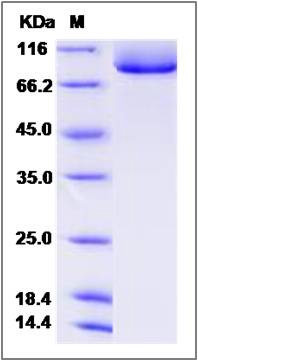Human TGFBR3 / Betaglycan Protein (His Tag)
betaglycan,BGCAN
- 100ug (NPP4305) Please inquiry
| Catalog Number | P10778-H08B |
|---|---|
| Organism Species | Human |
| Host | Baculovirus-Insect Cells |
| Synonyms | betaglycan,BGCAN |
| Molecular Weight | The secreted recombinant human TGFBR3 consists of 791 amino acids and predicts a molecular mass of 87.8 KDa. The apparent molecular mass of the protein is approximately 88 KDa in SDS-PAGE under reducing conditions. |
| predicted N | Met |
| SDS-PAGE |  |
| Purity | > 95 % as determined by SDS-PAGE |
| Protein Construction | A DNA sequence encoding the human TGFBR3 (Q03167-1) (Met 1-Gly781) was expressed with a C-terminal polyhistidine tag. |
| Bio-activity | |
| Research Area | Signaling |Signal Transduction |Growth Factor & Receptor |proteoglycans |
| Formulation | Lyophilized from sterile 20 mM Tris, 500 mM NaCl, pH 7.4. 1. Normally 5 % - 8 % trehalose, mannitol and 0.01% Tween80 are added as protectants before lyophilization. Specific concentrations are included in the hardcopy of COA. |
| Background | Betaglycan also known as transforming growth factor beta receptor III (TGFBR3), is a cell-surface chondroitin sulfate / heparan sulfate proteoglycan. TGFBR3 is a transforming growth factor (TGF)-beta type III receptor. This receptor is a membrane proteoglycan that often functions as a co-receptor with other TGF-beta receptor superfamily members. Ectodomain shedding produces soluble TGFBR3, which may inhibit TGFB signaling. Decreased expression of this receptor has been observed in various cancers. TGFBR3 is the TGF-β component most commonly downregulated among localized human prostate cancer studies. TGFBR3 knockdown led to focus formation and enhanced expression of CD133, a marker found on prostate cancer stem cells. TGFBR3 is an accessory receptor that binds to and modulates the activities of both transforming growth factor-beta (TGFβ) and inhibin, two members of the TGFβ superfamily of growth factors that regulate many aspects of reproductive biology. TGFBR3 is known to be expressed in adult testis and ovary, but little is known about this receptor during gonadogenesis. |
| Reference |
